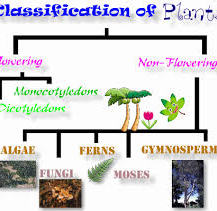Lesson Plan of Plants (Flowering & Non-Flowering Plants)
Lesson Plan of Plants (Flowering & Non-Flowering Plants)
General Science Grade V
Students’ Learning Outcomes
·
Compare flowering & non-flowering
plants.
·
Classify the flowering plants
into two major groups and give examples of each group.
Information for Teachers
·
Some plants produce flowers
and are called flowering plants e. g. orange, apple, wheat, rice, rose etc.
·
Some plants don’t produce
flowers and are called non-flowering plants e. g. ferns, conifers etc.
·
All the flowering plants
produce seeds in their life cycles. Their seeds are surrounding by the fruit. They
usually have broad leaves.
·
All non-flowering plants don’t
produce seeds. Conifers are the non-flowering plants that produce seeds. Their seeds
are not covered with fruit. They usually have needle-like leaves.
Material / Resources
Pictures of
flowering & non-flowering plants, textbook.
Worm up Activity
·
Recall students’
previous knowledge through questions like:
---What do you mean by classification?
---Why do we classify animals?
---Can we classify plants also?
·
After students’
response announce the today’s topic.
Development
Activity 1
·
Arrange the
students into appropriate number of groups.
·
Give pictures
of different plants to each groups.
·
Ask each
group to observe the plants shown in the pictures.
·
Students should
discuss the visible structure and different parts of the plants within the
group.
·
Ask students
to share their own knowledge about these plants within group.
·
Ask the
groups to share the important observations with the whole class (one member
from each group will present the observations).
·
Initiate and
guide the class discussion through interactive questioning:
--How the plants are different from one
another? (Expected response: They are different in sizes. They are different in
shapes. Some plants have flowers and fruits while some don’t have.)
* Ask them on
what basis we can classify them.(Expected response: shape, size and presence of
flowers).
* Conclude the
activity by explaining the first level of the classification of plants i. e.
flowering and non-flowering plants.
Activity 2
·
Write the
main characteristics of the two groups on board and fill it by the students’
response.
Characteristics
|
Flowering Plants
|
Non-flowering Plants
|
Produce Flower
|
Yes
|
No
|
Fruits
|
Present
|
Not present
|
Seeds
|
Produce in All
|
Not produce in all
|
Leaves
|
Usually Broad
|
Usually narrow
|
Examples
|
Rose, Apple, Wheat
|
Ferns, conifers
|
Sum up / Conclusion
·
Plants are
classified into two major groups i. e. flowering and non- flowering plants.
·
All the
flowering plants produce seeds in their life cycle. Their seeds are surrounded
by fruits. They usually have broad leaves.
·
The non-flowering
plants don’t produce seeds. There seeds are not covered with fruit. They usually
needle like leaves.
Assessment
·
Ask the
following questions to the students:
---What are
the two major groups of plants?
---How the
seeds of flowering plants are different from the seeds of some non- flowering
plants?
---In what
respects the flowering and non-flowering plants are similar?
---Name one
flowering and one non-flowering plant used in our daily life.
---In which
areas of Pakistan non-flowering plants are usually found?
·
Involve the
students in solving the questions given at the end of chapter / unit in
textbook.
Follow up
·
Ask the
students to go for a nature walk in their surroundings with their parents and
collect samples (for example leaves) from the flowering and non-flowering
plants.
·








Splendid lesson
ReplyDeleteI love it
Marvellously planneddddddd
ReplyDeleteI also like it. Thank u so much
ReplyDeleteVery systematically planned lesson.
ReplyDeleteExcellent 👌
ReplyDelete